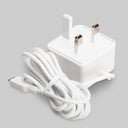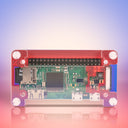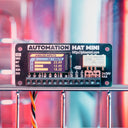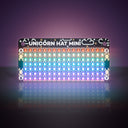Raspberry Pi Zero W
by Raspberry Pi
A tiny, single board computer with wireless and Bluetooth connectivity, perfect for embedded Internet of Things projects. Also available with pre-soldered headers!
The Zero W is a super-small, hackable, ultra-low-cost computer. It uses the same 40-pin GPIO arrangement as its larger siblings, so it's compatible with a wide range of addons - click here to view our extensive selection of HATs, pHATs, mini HATs, wHATs and SHIMs.
To attach HATs (and other things) to your Zero W you'll probably want to solder on a 40 pin header. The vanilla Zero W comes without a pin header, but you can pick up a Zero WH if you'd prefer one with a pre-soldered pin header, direct from the manufacturer.
Pi Zero boards use a mini HDMI port for connecting to a display and microB USB ports for connecting to power and USB devices. You can find adaptors for plugging in standard HDMI cables and standard USB A devices (like keyboards) in our adaptor kit (it comes with a 40 pin header too!). You can pick up a suitable power supply here.
If you're looking for something to protect your Pi, our Pibow Zero W case will safely ensconce it and protect it from bumps and bruises.
Features
- BCM 2835 SOC @ 1GHz
- 512MB of RAM
- On-board Wireless LAN - 2.4 GHz 802.11 b/g/n (BCM43438)
- On-board Bluetooth 4.1 + HS Low-energy (BLE) (BCM43438)
- micro-SD slot
- mini HDMI for display
- micro-B USB for data
- micro-B USB for power
- CSI camera connector *
- 40-pin GPIO connector (Zero W requires soldering)
- Compatible with existing pHAT/HAT add-ons
- Dimensions: 65mm x 30mm x 5mm
Notes
- Please be aware that the LED on your Zero W won't light up if there's no SD card or if there's a problem with the image. SD cards that work in other models of Pi are not guaranteed to work in your Zero W, so it's worth flashing a fresh image if you're having problems.
- You will require at least NOOBS 2.2.0 (27th Feb 2017) or Raspbian 2017-02-27 or newer. The instructions from the Raspberry Pi Foundation here will guide you on how to flash Raspberry Pi OS to your SD card.
- * The CSI camera connector on the Pi Zero is smaller than the one on full size Raspberry Pis. You may need an adaptor cable if you want to plug in an official Raspberry Pi camera.
-
Zero W
SC0020£11.25 -
Zero WH (pre-soldered)
SC0065Out of stock£12.60
Pi Zero Essentials
Useful items for connecting to your Pi
-
 Raspberry Pi 12.5W Micro USB Power Supply (for Pi Zero 2 W, 3 B+ and earlier)+ £7.50
Raspberry Pi 12.5W Micro USB Power Supply (for Pi Zero 2 W, 3 B+ and earlier)+ £7.50 -
Raspberry Pi Zero Adaptor Kit+ £4.75
-
GPIO Hammer Header (Solderless)+ £6.00
-
Three Port USB Hub with Ethernet (micro B)+ £8.25
-
 Pibow Zero W+ £5.00
Pibow Zero W+ £5.00 -
Male 40-pin 2x20 HAT Header+ £0.83
Mini HATs
Add more functions to your Pi with a fancy add-on board
-
 Automation HAT Mini+ £18.75
Automation HAT Mini+ £18.75 -
 Unicorn HAT Mini+ £18.25
Unicorn HAT Mini+ £18.25 -
 Breakout Garden Mini (I2C + SPI)+ £9.00
Breakout Garden Mini (I2C + SPI)+ £9.00
Need larger quantities? Bulk orders can be placed via our wholesale store! ❤️
Shop with confidence – we've been serving the hobbyist electronics, Maker, and retro gaming communities since 2012.
- Satisfaction or refund guarantee
- Worldwide shipping via mail or courier
- 57,000+ customer reviews
- Approved Raspberry Pi Reseller
- Secure website and payments





